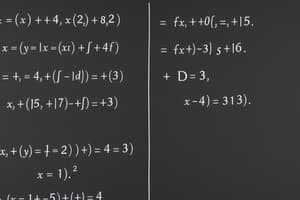Podcast
Questions and Answers
What is the name of the set X in the context of functions?
What is the name of the set X in the context of functions?
Domain
Given a relation f: X →Y, what condition must hold for f(x) to be a function?
Given a relation f: X →Y, what condition must hold for f(x) to be a function?
For every x ∈ X, there must exist a unique y ∈ Y such that y = f(x).
The vertical line test is used to determine if a relation is a function graphically.
The vertical line test is used to determine if a relation is a function graphically.
True (A)
Which of the following relations is a function?
Which of the following relations is a function?
A function from a set D to a set Y is a ______ that assigns a unique element to each element in D.
A function from a set D to a set Y is a ______ that assigns a unique element to each element in D.
The output of a function is also known as its range.
The output of a function is also known as its range.
What is the horizontal line test used to determine?
What is the horizontal line test used to determine?
Which of the following functions is one-to-one?
Which of the following functions is one-to-one?
What is the inverse of a function?
What is the inverse of a function?
A function and its inverse are always symmetrical about the line y = x.
A function and its inverse are always symmetrical about the line y = x.
What is the first step typically involved in finding the inverse of a function?
What is the first step typically involved in finding the inverse of a function?
How can you graphically find the inverse of a function?
How can you graphically find the inverse of a function?
Flashcards
Function
Function
A rule that assigns a unique element from a set (Y) to each element of another set (X).
Vertical Line Test
Vertical Line Test
A graphical method to determine if a graph represents a function. A graph is a function if no vertical line intersects the graph more than once.
Domain
Domain
The set of all possible input values (x) for a function.
Range
Range
Signup and view all the flashcards
One-to-One Function
One-to-One Function
Signup and view all the flashcards
Horizontal Line Test
Horizontal Line Test
Signup and view all the flashcards
Inverse Function
Inverse Function
Signup and view all the flashcards
f⁻¹(x)
f⁻¹(x)
Signup and view all the flashcards
f(x)=2x+1
f(x)=2x+1
Signup and view all the flashcards
y=x²
y=x²
Signup and view all the flashcards
y=x³
y=x³
Signup and view all the flashcards
Finding the inverse of a function
Finding the inverse of a function
Signup and view all the flashcards
f(x) = √x
f(x) = √x
Signup and view all the flashcards
f(x) = 1/x
f(x) = 1/x
Signup and view all the flashcards
Graph Symmetry
Graph Symmetry
Signup and view all the flashcards
Algebraic method for inverse
Algebraic method for inverse
Signup and view all the flashcards
Graph method for inverse
Graph method for inverse
Signup and view all the flashcards
g(f(x)) = x
g(f(x)) = x
Signup and view all the flashcards
f(x) is one-to-one
f(x) is one-to-one
Signup and view all the flashcards
Domain of f⁻¹(x)
Domain of f⁻¹(x)
Signup and view all the flashcards
Study Notes
Functions
- A function maps elements from a set (domain) to a set (co-domain)
- A function assigns a unique output value for each input value
- Algebraically: for all x in the domain, there's a unique y in the co-domain such that y = f(x)
- Graphically: the vertical line test - a relation is a function if any vertical line intersects the graph at most once.
Example Functions
- f(x) = 2x + 1 is a function
- x² + y² = 9 is not a function
Domain and Range
- Domain: the set of all possible input values (x-values)
- Range: the set of all possible output values (y-values)
Examples of function Types and Domains
- y = x² Domain: (-∞, ∞) Range: [0, ∞)
- y = 1/x Domain: (-∞, 0) U (0, ∞) Range: (-∞, 0) U (0, ∞)
- y = √x Domain: [0, ∞) Range: [0, ∞)
- y = √(4 - x) Domain: (-∞, 4] Range: [0, ∞)
- y = √(1 - x²) Domain: [-1, 1] Range: [0, 1]
One-to-One Functions
- A function f(x) is one-to-one if f(x₁) ≠ f(x₂) whenever x₁ ≠ x₂
- Algebraically: f(x₁) = f(x₂) implies x₁ = x₂
- Graphically: the horizontal line test - a function is one-to-one if any horizontal line intersects the graph at most once.
Inverse Functions
- An inverse function reverses the relationship of a one-to-one function
- g(x) is the inverse of f(x) if g(f(x)) = x for all x in the domain of f(x) and f(g(x))=x for all x in the domain of g(x).
- Notation: g(x) is often written as f⁻¹(x).
- f⁻¹(f(x)) = x and f(f⁻¹(y)) = y
- To find the inverse, solve for x in terms of y, then swap x and y.
- Example: If y = (1/2)x + 1, f⁻¹(x) = 2x - 2
How to Sketch the Inverse
- Draw the line y = x
- Reflect the graph of f over the line y = x. The reflection is f⁻¹(x)
Finding an Inverse Function
- Given a function, replace y with f(x). Solve for x in terms of y. Swap x and y. Replace y with f⁻¹(x).
- Example: if y=√x then x = y^2 and f^(-1) (x)=x^2.
Studying That Suits You
Use AI to generate personalized quizzes and flashcards to suit your learning preferences.




